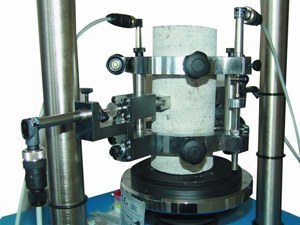Single axis tests with LVDT sensors
Standards D3148, D2938, D5407, D264
The purpose of the test is to establish a method to determine stress-deformation curves, elasticity modulus (Young) and Poisson coefficient on the single axis compression of a regular cylindrical specimen. LVDT sensors are the best option when the nature of the rock does not allow for placement of extensometric bands. This occurs in very porous rocks, plastic rocks or rocks of a with very plastic behaviour. A compression gauge is required to position the LVDTs. Two LVDTs are positioned to measure diametral deformation and another two are placed to measure axial deformation. Data is collected by computer, although the data from the LVDT first passes through a data collection box that carries out the analogue / digital conversion. The software performs the process automatically, starting the test, controlling the cycles, collecting data, etc. The data can be viewed in real time while the test is being performed.
The system is exportable, i.e., these tests can be performed with other concrete presses other than those manufactured by PROETI.
Equipment required
2000 kN to 3000 kN press with computer control. The press has to be servo-controlled. Ideally, it would allow gradient control during loading and unloading (see
concrete section). In many cases, electro-mechanical multipurpose testing machines can be used for these tests, depending on the rock section to be tested.
LVDT sensors.
Data collection box with 16 channels.
Compatible PC.
Data collection card.
Elasticity software.
H0235 3000 kN press.
S0373 Multipurpose testing machine for 300 kN.
S0237 LVDT 2 mm sensor.
S0200 Data collection box.
H0253 Compression gauge/extensometer.
H0235PC Compatible PC.
H0235/2 Elasticity software.
 Testlab
Testlab






